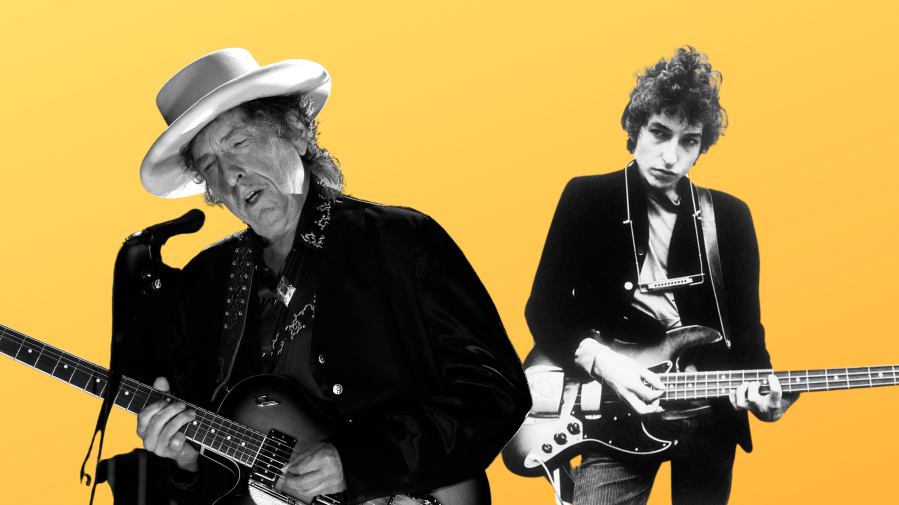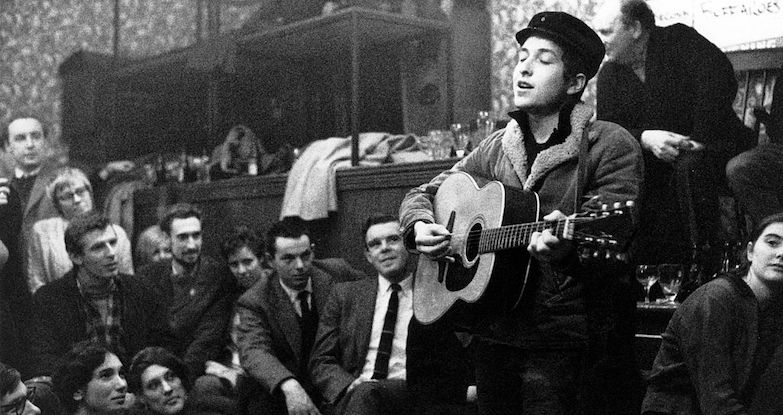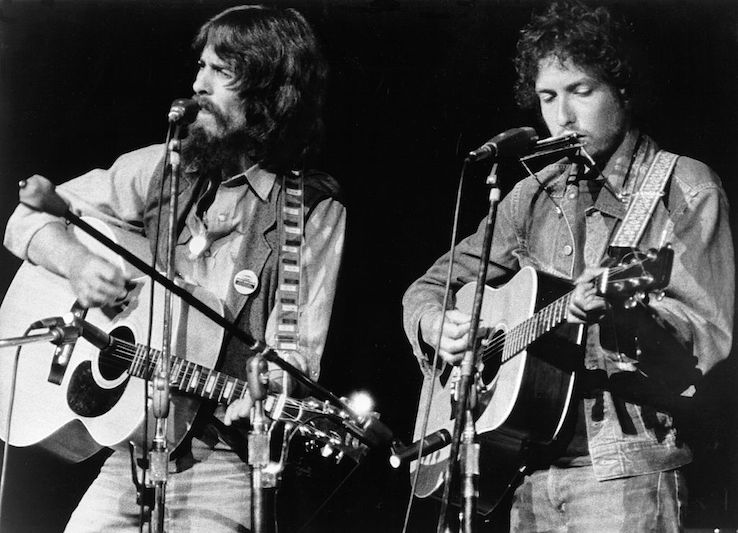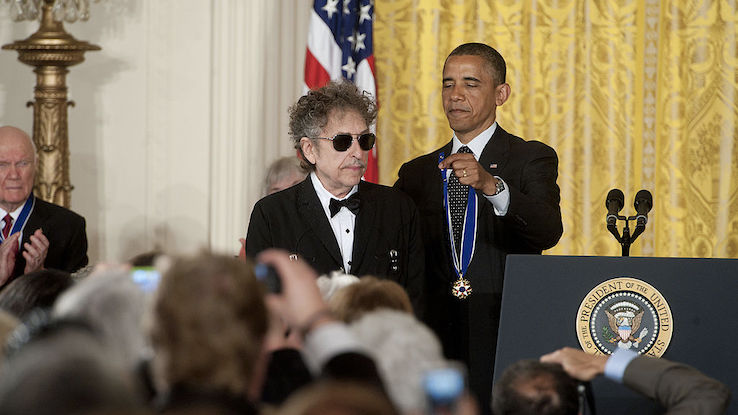Katy and Bob Way Back Home 2 Review

Bob Dylan is often referred to equally the vocalism of a generation. Throughout his career, which has spanned more than half a century, his lyrics accept touched the hearts of millions. And his affect on the musical mural has only go more undeniable. March 19 marks lx years since the release of his first album, the eponymous Bob Dylan, and he's still enchanting audiences with his "freewheelin'" performances and the independent perspective that's defined his body of work.
This icon has lived many lives in his decades-long career, and Dylan truly does "incorporate multitudes," as expressed on his 2020 studio anthology Rough and Rowdy Means. Throughout his many reincarnations, he's also remained a symbol of spirited provocation. From bringing awareness to injustice around the globe to encouraging people to look beyond themselves in the turbulent 1960s and today, Dylan continues to deliver authenticity and invite curiosity on tour and at residuum. In celebration of these and other notable contributions he's fabricated to the worlds of music, civil rights, politics and even morality itself, nosotros're taking a look at The Bard'southward indelible legacy.
Dylan's Humble Ancestry Led Him to the Big Apple tree

Born Robert Allen Zimmerman in 1941, Dylan's love affair with music began during his childhood in Minnesota. Early on, legendary artists like Little Richard, Hank Williams and Woody Guthrie captured immature Dylan's attention and led him to explore music more seriously. Throughout high schoolhouse, he played with diverse bands, performing covers of Elvis and Little Richard songs while honing his skills on the guitar and pianoforte.
In 1959, while studying at the University of Minnesota, he started to introduce himself as Bob Dylan, a name he chose subsequently discovering works by the Welsh poet Dylan Thomas. By 1960 he'd get fully invested in learning more than most Beat poetry and folk music, so he left schoolhouse to pursue a new life in New York Urban center — and hopefully connect with his bilious idol, Woody Guthrie, who was hospitalized nearby in New Bailiwick of jersey.
Like many young artists, Bob Dylan was inspired by the rich civilization of New York and began to connect with other musicians while developing his own manner. After settling in the city, he started performing at folk clubs in the Greenwich Hamlet neighborhood and was somewhen spotted past a talent scout who signed him to Columbia Records.
In 1962 he released his debut cocky-titled album, which drew largely from the many influences he'd encountered up to that bespeak. Unfortunately, it wasn't a commercial success — only it was an of import stepping stone. His second record, 1963'sThe Freewheelin' Bob Dylan, was where his voice truly emerged, and it would be this anthology that started to solidify his presence as a protestation vocalizer fighting for change. Long before the days of social media awareness campaigns, Dylan had begun to cast a glaring light on individual instances of injustice and racist violence while providing a soundtrack for a populace committed to changing the status quo.

Bob Dylan boldly stood confronting oppression as an private and an creative person, and this reputation defined much of his career. Through anti-war anthems similar "Masters of State of war" and provocative inquiries similar "Blowin' in the Wind," Dylan cemented himself equally a thoughtful songwriter who refused to shy abroad from controversy. He performed at the 1963 March on Washington, and though he has never been interested in audition reverence for his positions on moral topics, his involvement in anti-war protests and the Civil Rights Movement helped to movement the needle toward progress. "You couldn't help but feel the bicycle of history turning," Peter Koper, who saw Dylan perform live at the March on Washington, told The New York Times.
Always an innovator, Bob Dylan too inverse the landscape of folk music in addition to challenging the establishment. His early rock influences and tendency toward innovation led him to create music that expanded the folk genre. In just one example, his experimentation with the electrical guitar in 1965 was met with a mixed reception by the Newport Folk Festival crowd. But that didn't cease him from pushing boundaries and creating music that authentically represents who he may exist at any given moment, "whoever that is."
The Artist Remains a Living Legend

Though he famously rejected the championship of poet — "I recall of myself more as a vocal and dance man, y'know," he once told reporters at a press briefing — and initially even rejected his Nobel Prize for Literature, his artistry seemingly knows no bounds. In addition to winning countless Grammy awards, this ever-evolving creative force is likewise an accomplished visual artist. Some of his pieces, which range from paintings to sculptures, tin exist establish on his personal website; The Guardian's Jonathan Jones has described them equally "evocative celebrations of life itself." The largest collection of his drawings, paintings and sculptures to date, totaling over 100 original works, can be found at the Patricia & Phillip Frost Museum in Miami, Florida.
Since his offset tape debuted six decades ago, Bob Dylan has released nearly twoscore albums and shows no signs of hanging up his guitar. And he's not just a musical legend. Though he is a well-decorated musician with such accolades equally a Presidential Medal of Liberty, a Nobel Prize and endless other high honors, he's not defined by awards or his reputation. He continues to unfold and discover himself, even every bit the 60th anniversary of his fourth dimension in the spotlight passes.
Bob Dylan truly embodies the idea of "loving the fine art in yourself, not yourself in the fine art" championed by the famed theater artist Konstantin Stanislavski. His willingness to explore new artistic ideas and embrace marvel — and even chaos — highlights the power of the impulse to create, while his personal convictions celebrate the brilliance and beauty of everyday people. Every bit he continues his Never Catastrophe Bout — which began in June of 1988 — nosotros'll keep waiting to see what "consummate unknowns" Dylan surprises us with next.
Source: https://www.ask.com/entertainment/bob-dylan-album-anniversary?utm_content=params%3Ao%3D740004%26ad%3DdirN%26qo%3DserpIndex
0 Response to "Katy and Bob Way Back Home 2 Review"
Post a Comment